Active filters:
- Remove this filter Category: Water Management
Available filters Toggle display
- Price
Publications
Need to be tax-exempt?
Contact Laura Tharnish before ordering.
ltharnish2@unl.edu or 402-472-1576
-
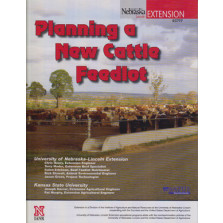
Planning a New Cattle Feedlot
$2.50Construction of a new feedlot or expansion of an existing feedlot requires planning.
This 16-page Extension Circular covers the entire planning process and covers:
- Initial site planning and elements to consider in construction • Pen size and arrangement
- Lighting, fencing, gates, and wind protection
- Runoff control regulations, groundwater issues, and configuring a control system
- Odor and air quality
- Diversions, collection channels, and drains
- Holding ponds and outlets
- Land application
- Vegetative treatment systems
-
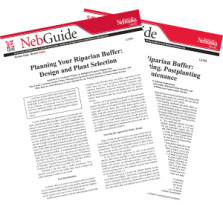
Planning and Installing a Riparian Buffer
$1.00Riparian buffers are a best management practice to protect stream water quality, reduce streambank erosion, and provide wildlife habitat. Riparian buffers may fulfill conservation program requirements and serve as an income source for federal, state and local cost-share programs or the production and sale of specialty crops. These two, 4-page publications guide you through design, plant selection, planting, and maintenance of riparian buffers.
You also may be interested in a related UNL Extension DVD, Installing and Maintaining Your Riparian Buffer.
Learn More -
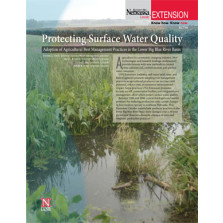
Protecting Surface Water Quality
$2.00Between 1996 and 2006, farmers in the Big Blue River Basin in southeast Nebraska adopted a number of best management practices to help increase yield, reduce costs, and minimize environmental impacts. This Extension Circular documents the dramatic changes over this 10-year period in corn and sorghum operations related to tillage, irrigation, fertilization, water conservation, pest management practices, and cropping systems. Research and data from grower surveys is well illustrated with graphics, maps, photos, and tables.
Learn More -
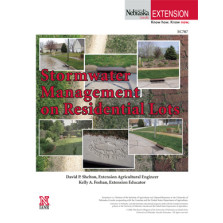
Stormwater Management on Residential Lots
$2.50When water from rain or melting snow can’t soak into the ground, it flows over lawns, structures, pavement, and bare soil, collecting contaminants and soil particles which are carried to local lakes and rivers. This publication looks at how stormwater runoff develops and describes basic low-cost, low-maintenance steps that landowners can take to reduce unintended pollution. 8 pages. Learn More -
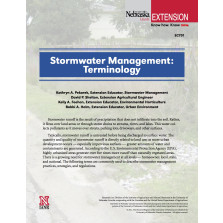
Stormwater Management: Terminology
$1.00Not available online
Stormwater runoff occurs when precipitation does not infiltrate soil, but instead, flows over land or through storm drains to streams, rivers, and lakes. This water collects pollutants as it moves over streets, parking lots, driveways, and other surfaces. To reduce pollution, it’s important to manage this stormwater runoff at the home, city, state, and national levels. This 12-page Extension Circular presents commonly used terms in stormwater management practices, strategies, and regulations. Learn More -

Stormwater Sleuth & Running Rain
$2.00Follow Stormwater Sleuth and Running Rain through their comic book adventure where youth with learn about storm water runoff, water pollution from runoff, and practices that help slow stormwater and keep runoff clean. Youth can explore the watershed they live in and the storm water runoff from their home or school, and discover ways they can be a part of the solution to stormwater runoff pollution.
The book includes a maze, crossword puzzle and two hands-on activities that promote exploration and observation of storm water runoff pollution.
Format: 16 pages, B/W
Learn More -
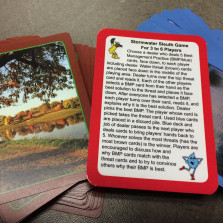
Stormwater Sleuth Game
$20.00Based on the Stormwater Sleuth Comic book, you can learn about different water threats and ways to address them in this fun and engaging card came.
Each deck of cards contains 40 different threats to water and 80 best management practices.
Learn More -
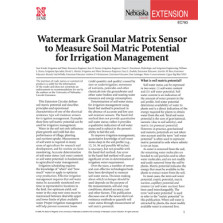
Watermark Granular Matrix Sensor to Measure Soil Matric Potential for Irrigation Management
$0.00This Extension Circular defines soil matric potential and describes principles and operational characteristics of one of the electrical resistance type soil moisture sensors for irrigation management. It also covers basic equipment and installation, soil temperature effects on soil matric potential, system maintenance and trouble shooting. This publication is a valuable reference for growers incorporating this soil water measurement tool into their farming operation. Learn More